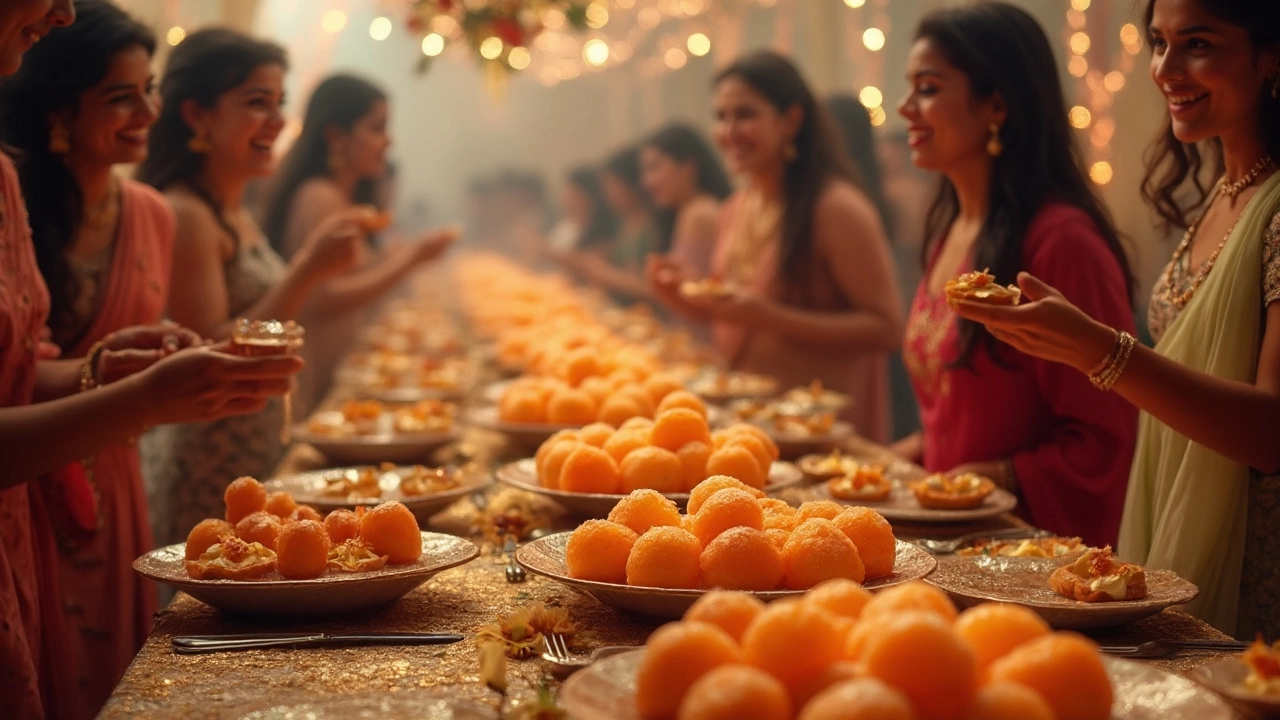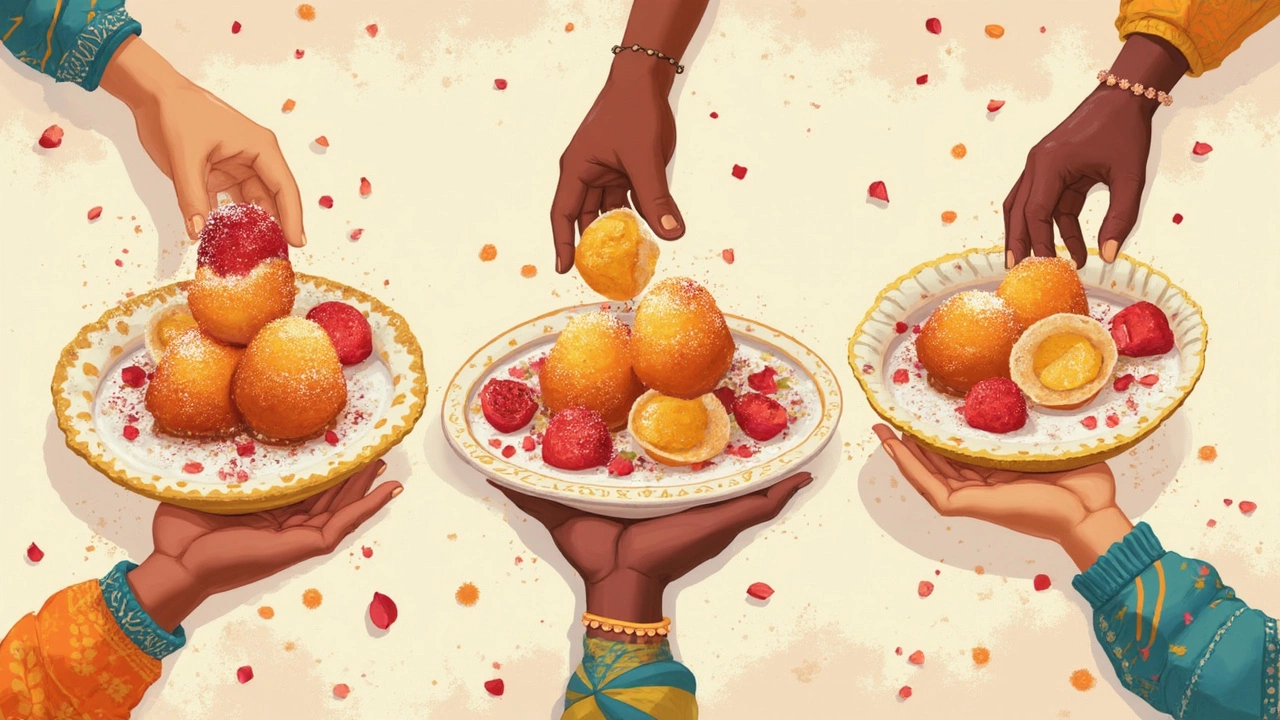Everyone craves that one dessert after a meal that feels like a warm hug. In India, Gulab Jamun ticks that box almost every time. Imagine soft, spongy balls soaked in fragrant sugar syrup, melting in your mouth with every bite. People love it not just because it’s sweet, but because it brings back memories—from birthday parties to huge wedding feasts.
Getting your Gulab Jamun right at home is easier than you’d think. The dough isn’t complicated, and the syrup uses basic pantry staples. The real trick is in the frying—keep the heat low so the balls cook all the way through without burning. Trust me, nothing beats the taste of homemade Gulab Jamun, especially when you serve it warm or with a scoop of vanilla ice cream on a hot day.
Ever wondered why it’s so deeply rooted in Indian celebrations? This simple sweet manages to bridge generations and regions. No matter where you are in India, you’ll find it on the dessert table, often disappearing faster than anything else!
- Why Gulab Jamun Steals the Spotlight
- A Quick Look at Its History
- Best Ways to Serve and Enjoy
- Tips for Making Perfect Gulab Jamun at Home
- Surprising Facts and Regional Variations
Why Gulab Jamun Steals the Spotlight
There’s a reason gulab jamun is the first thing people reach for at any party, wedding, or festival in India. This sweet isn’t just popular; it’s almost mandatory at big family celebrations. Most dessert tables in India feel empty without it.
One big reason for its fame is its simplicity. Made mostly of milk solids (khoya) and a basic sugar syrup, it still manages to deliver big flavor. Indian households, caterers, and even street vendors swear by its appeal. According to a 2024 market study, more than 65% of Indian sweet shops report gulab jamun as their best-selling item. That’s not just a coincidence—it’s a telling sign of how much people love it.
“Gulab Jamun is the sweet that brings people together and ends every celebration on a happy note,” says Chef Sanjeev Kapoor, one of India’s most well-known culinary experts.
Another cool thing: it’s easy to serve and eat. No fancy forks, no mess—just pick it up with a spoon or even your hand. You can have it hot, cold, or even straight out of the fridge. Some folks even love to pair it with vanilla ice cream or rabri.
- Indian sweets like gulab jamun are a hit for their adaptability—every region, from North to South, serves it differently.
- Kids love the super soft texture, while older folks go for the nostalgic taste.
- It’s vegetarian and fits religious or fasting diets easily.
Besides all that, it’s a flavor everyone can agree on—sweet, slightly floral, and a little rich. You’ll find people sneaking extra helpings, no matter their age. For many, a celebration just feels incomplete without gulab jamun stealing the show.
| Occasion | % Served With Gulab Jamun |
|---|---|
| Weddings | 95% |
| Festivals (Diwali, Holi, Eid) | 98% |
| Birthday Parties | 85% |
A Quick Look at Its History
It might surprise you, but Gulab Jamun didn’t exactly start out in India. Most food historians agree that it originally came from what is now Iran, introduced during the Mughal period. The word “Gulab” comes from the Persian for rose (gul) and water (ab), because the sugar syrup was traditionally flavored with rose water. “Jamun” is named after a local fruit with a similar shape and color.
The Mughal chefs started playing around with milk solids (khoya) and basic wheat flour, creating what looked a little like baby doughnuts dunked in sweet syrup. Over time, Indian cooks made it their own by adding cardamom, saffron, and sometimes using paneer instead of just khoya. Now you’ll spot Gulab Jamun everywhere from luxury hotels in Mumbai to tiny sweet shops in Kolkata.
By the 20th century, Indian sweets like Gulab Jamun had cemented their place in every major celebration. During Diwali, Holi, Eid, and even Christmas, it’s the first dish emptied out from the sweets tray. A 2018 survey by a major Indian food delivery app found Gulab Jamun as the top ordered dessert during festive seasons, beating out contenders like rasgulla and jalebi by a mile.
| Year | Milestone |
|---|---|
| 16th Century | Gulab Jamun introduced by Mughals |
| 1800s | Adopted and modified in regional kitchens |
| 20th Century | Appears on most Indian festive menus |
| 2018 | Ranked India’s favorite dessert in surveys |
So next time you dig into this soft, syrupy treat, you’re really tasting a bit of food history that’s traveled and transformed over hundreds of years. It’s proof that the best dishes are the ones everyone wants to claim as their own.

Best Ways to Serve and Enjoy
As far as gulab jamun goes, there’s really no wrong way to eat it. But a few tried-and-true tricks can make this Indian sweet even more irresistible. Whether you want to impress guests or just satisfy your own cravings, how you serve it matters almost as much as how you make it.
- Hot or Cold: Some people swear by warm gulab jamuns, especially fresh out of the syrup. Others like them chilled, right from the fridge. If you’re serving them at a party, give folks both options and let them pick!
- Ice Cream Partner: One of the easiest upgrades is to serve gulab jamun with vanilla or even butterscotch ice cream. The hot-cold combo, plus the gooey syrup, makes this a dessert no one forgets.
- Festive Plating: At weddings, gulab jamun is often topped with sliced pistachios, almonds, or edible silver foil (varq). Not only does it look fancy—it adds texture and subtle flavor.
- Cuts and Layering: Some home cooks cut the balls in half and layer them with whipped cream or custard for a fun twist, especially if you’re making a quick trifle for guests.
- Portion Size: For festivals, bite-sized mini gulab jamuns are easier to serve and less messy. Kids especially love these tiny treats!
If you’re wondering what drinks go best with gulab jamun, chai is a classic pick. But for summer, cold milk or lassi does the job nicely, balancing all the sweetness.
Gulab jamun shows up not just at home but in restaurants across India and even in Indian restaurants worldwide. According to a 2024 Zomato survey, it was the most-ordered dessert in Indian metros, beating out rasgulla and jalebi.
| Serving Style | Occasion | Popularity (India, %) |
|---|---|---|
| Warm with syrup | Weddings/Festivals | 53% |
| Chilled | Summer Parties | 25% |
| With ice cream | Restaurants | 15% |
| Mini/Bite-size | Kids' Parties | 7% |
Mix up your serving style based on the occasion and the crowd. One thing's clear—when you’re dealing with this iconic Indian dessert, there’s no shortage of delicious ways to do it right.
Tips for Making Perfect Gulab Jamun at Home
Making gulab jamun at home is totally doable—even if you're a beginner in the kitchen. If you follow a few smart steps, your homemade Indian sweets will rival what you get at any sweet shop.
Start by choosing the right ingredients. Traditionally, gulab jamun is made with khoya (milk solids), but milk powder works well if you can’t find khoya. Make sure your baking powder is fresh, because that’s what will make your balls light and spongy.
- Don’t overwork the dough: Gently mix your ingredients just until combined. Over-mixing makes the jamuns tough.
- Keep the balls small and smooth: Roll them lightly to avoid cracks. Cracks can make them fall apart in the syrup.
- Low and slow frying: Set your oil or ghee on medium-low heat. If the oil’s too hot, the gulab jamun will brown outside but stay raw inside. Give each batch at least five to seven minutes, stirring gently for even color.
- Sugar syrup right: Aim for a sticky, not thick, syrup. Mix one part water to one part sugar (for example, 2 cups each) with a splash of rose water or cardamom. Warm syrup ensures the balls soak up maximum flavor.
- Soak time: Drop the hot fried balls into warm syrup and let them soak for at least 2 hours. The longer you wait, the softer and juicier they get.
If you like numbers, here’s the basic syrup ratio—so you don’t have to guess:
| Ingredient | Amount |
|---|---|
| Sugar | 2 cups |
| Water | 2 cups |
| Cardamom pods | 4-5 |
| Rose water | 1-2 tsp |
Want extra tips? Use soft hands when shaping the balls, and don’t crowd the oil—fry in small batches. And if you want to freeze them, skip the soaking and freeze just the fried jamuns. Add them to hot syrup when you’re ready to serve.

Surprising Facts and Regional Variations
Most people know gulab jamun as the star of Indian desserts, but there’s way more to it than just being a sweet ball in syrup. Here are some facts that often surprise even long-time fans.
- The name ‘gulab jamun’ is a mash-up: ‘Gulab’ comes from the Persian word for rose, because of the rose-flavored syrup, while ‘jamun’ is a berry native to India that the sweetness is named after because they look alike.
- It’s not originally Indian! Historians say the recipe actually came from Persia, then kicked off its own fanbase after landing in Mughal kitchens.
- Some regions in India swap out ingredients: For example, South Indian versions may use khoya (milk solids), but in Bengal, ‘Pantua’ is similar but made with chhena (fresh paneer).
- If you’re wondering about variety, try ‘Kala Jamun.’ It’s like gulab jamun, but darker and sometimes stuffed with nuts or dried fruit.
- Gulab jamun is served hot, cold, plain, with ice cream, or even with rabri, showing off how flexible this dessert really is.
Check out just how diverse Indian sweets recipes look with different versions across the country:
| Region | Name | Main Difference |
|---|---|---|
| North India | Gulab Jamun | Made with khoya, classic rose syrup |
| West Bengal | Pantua | Uses chhena, fried longer for a crisper shell |
| Maharashtra | Dry Gulab Jamun | No syrup, rolled in sugar instead |
| South India | Gulab Jamun | Uses milk powder when khoya isn’t available |
No matter where you try it, there’s always a local twist. Even outside India, countries like Nepal and Bangladesh have put their own spin on popular desserts like gulab jamun. It just shows that this sweet is truly everyone’s favorite at any party.
